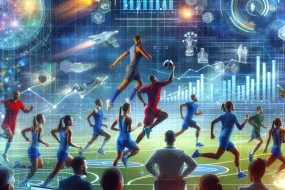
In the ever-evolving world of sports therapy, the integration of artificial intelligence (AI) is shaping a future where athletes can recover faster and more efficiently than ever before. As technology continues to advance, the realm of sports recovery is seeing a paradigm shift, enabling tailored treatments, predictive injury assessments, and personalized rehabilitation plans. This article delves into how AI is revolutionizing sports therapy, offering a glimpse into a future where recovery is not just quicker but smarter.
The Intersection of AI and Sports Therapy
Artificial intelligence is no longer a concept confined to science fiction or tech startups. It has permeated various industries, and sports therapy is no exception. The application of AI in this field is not just a trend but a transformative force. By leveraging machine learning algorithms and data analytics, sports therapists can now provide athletes with recovery plans that are specifically tailored to their individual needs. This personalized approach is a game-changer, offering athletes a better chance at achieving optimal recovery outcomes.
Personalized Recovery Plans: The New Normal
Gone are the days of one-size-fits-all recovery plans. With AI, therapists can analyze vast amounts of data, including an athlete's medical history, injury specifics, and even genetic information, to devise a recovery strategy that is uniquely suited to the individual. This level of personalization ensures that every aspect of an athlete's recovery is optimized, from the type of therapy used to the duration and intensity of sessions. It's a holistic approach that addresses the nuances of each athlete's condition, leading to faster and more effective recovery times.
Predictive Injury Assessments: Staying Ahead of the Game
One of the most exciting developments in sports therapy is the use of AI for predictive injury assessments. By analyzing an athlete's performance data, AI can identify patterns and anomalies that may indicate a heightened risk of injury. Early detection means that preventative measures can be put in place, reducing the likelihood of injuries occurring in the first place. This proactive approach not only keeps athletes on the field but also extends their careers by minimizing the wear and tear on their bodies.
Real-Time Feedback: A Coach in Your Pocket
Imagine having a personal coach who provides real-time feedback during your training sessions. With AI, this is becoming a reality. Wearable technology equipped with AI capabilities can monitor an athlete's movements, providing instant feedback on form and technique. This immediate input helps athletes make necessary adjustments on the fly, preventing incorrect practices that could lead to injury. It's like having a vigilant coach who never misses a beat, ensuring that athletes are always performing at their best.
Common Mistakes to Avoid in AI-Driven Recovery
While the benefits of AI in sports therapy are numerous, there are pitfalls to be aware of.
1) Over-reliance on technology: It's essential not to disregard the human element in therapy.
2) Ignoring data privacy: With AI collecting vast amounts of personal data, ensuring privacy and security is paramount.
3) Misinterpretation of data: AI is a tool, not a replacement for professional judgment. Therapists must interpret AI data correctly to avoid misguided treatment plans.
The Road Ahead: Challenges and Opportunities
The integration of AI in sports therapy is not without its challenges. There are concerns about data privacy, the cost of AI technologies, and the need for ongoing training for therapists to effectively use these tools. However, the opportunities far outweigh the challenges. As AI technology becomes more accessible and affordable, its adoption in sports therapy is expected to grow, paving the way for innovations that we can only begin to imagine. The future of sports therapy is bright, with AI leading the charge towards more efficient and effective recovery processes.




























